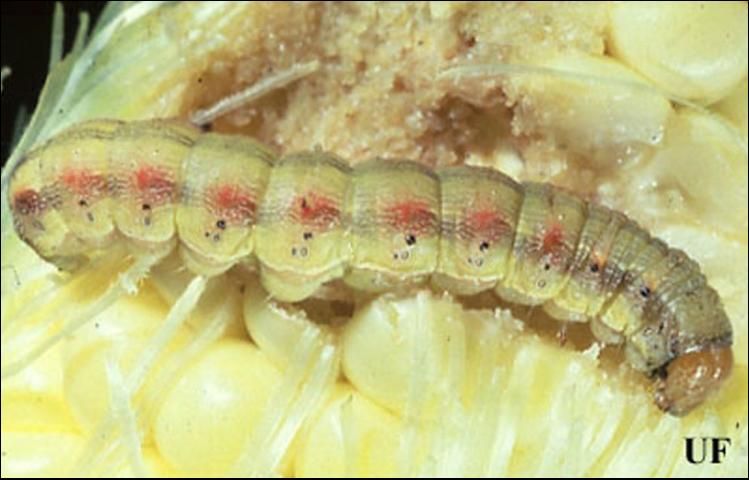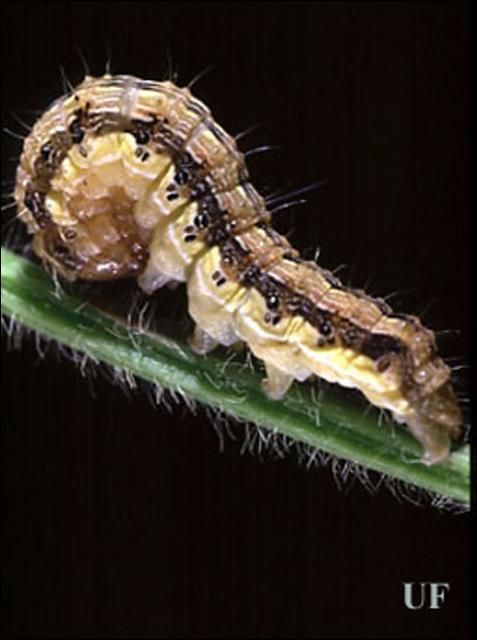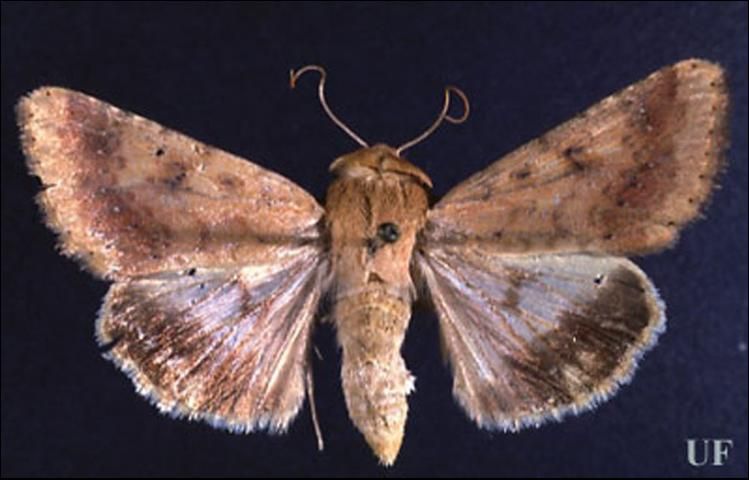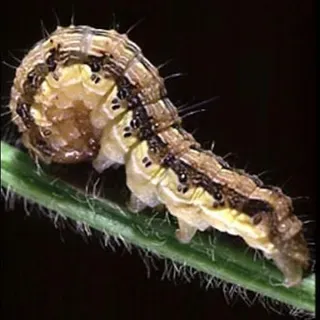Corn Earworm, Helicoverpa zea (Boddie) (Lepidoptera: Noctuidae)
The Featured Creatures collection provides in-depth profiles of insects, nematodes, arachnids and other organisms relevant to Florida. These profiles are intended for the use of interested laypersons with some knowledge of biology as well as academic audiences.
Distribution
Corn earworm is found throughout North America except for northern Canada and Alaska. In the eastern United States, corn earworm does not normally overwinter successfully in the northern states. It is known to survive as far north as about 40 degrees north latitude, or about Kansas, Ohio, Virginia, and southern New Jersey, depending on the severity of winter weather. However, it is highly dispersive, and routinely spreads from southern states into northern states and Canada. Thus, areas have overwintering, both overwintering and immigrant, or immigrant populations, depending on location and weather. In the relatively mild Pacific Northwest, corn earworm can overwinter at least as far north as southern Washington.
Life Cycle and Description
This species is active throughout the year in tropical and subtropical climates but becomes progressively more restricted to the summer months with increasing latitude. In northeastern states dispersing adults may arrive as early as May or as late as August due to the vagaries associated with weather; thus, their population biology is variable. The number of generations is usually reported to be one in northern areas such as most of Canada, Minnesota, and western New York; two in northeastern states; two to three in Maryland; three in the central Great Plains; and northern California; four to five in Louisiana and southern California; and perhaps seven in southern Florida and southern Texas. The life cycle can be completed in about 30 days.
Egg
Eggs are deposited singly, usually on leaf hairs and corn silk. The egg is pale green when first deposited, becoming yellowish and then gray with time. The shape varies from slightly dome-shaped to a flattened sphere, and measures about 0.5 to 0.6 mm (< 1/16 in) in diameter and 0.5 mm (< 1/16 in) in height. Fecundity ranges from 500 to 3000 eggs per female. The eggs hatch in about three to four days.
Larva
Upon hatching, larvae wander about the plant until they encounter a suitable feeding site, normally the reproductive structure of the plant. Young larvae are not cannibalistic, so several larvae may feed together initially. However, as larvae mature, they become very aggressive, killing and cannibalizing other larvae. Consequently, often only one mature larvae is found in each ear of corn. Normally, corn earworm displays six instars, but five is not uncommon and seven to eight have been reported. Mean head capsule widths are 0.29, 0.47, 0.77, 1.30, 2.12, and 3.10 mm (< 1/16, < 1/16, 1/16, between 1/16 and 1/8, and 1/8 in), respectively, for instars 1 to 6. Larval lengths are estimated at 1.5, 3.4, 7.0, 11.4, 17.9, and 24.8 mm (1/16, 1/8, ¼, 3/8, ¾, and 1 in), respectively. Development time averaged 3.7, 2.8, 2.2, 2.2, 2.4, and 2.9 days, respectively, for instars 1 to 6 when reared at 25°C (77°F). Butler (1976) cultured earworm on corn at several temperatures, reporting total larval development times of 31.8, 28.9, 22.4, 15.3, 13.6, and 12.6 days at 20.0, 22.5, 25.0, 30.0, 32.0, and 34.0°C (68, 72.5, 77, 86, 89.6, and 93.2°F), respectively.
The larva is variable in color. Overall, the head tends to be orange or light brown with a white net-like pattern. The thoracic plates are black, and the body is brown, green, pink, or sometimes yellow or mostly black. The larva usually bears a broad dark stripe laterally above the spiracles, and a light yellow to white stripe below the spiracles. A pair of narrow dark stripes often occurs along the center of the back. Close examination reveals that the body bears numerous black thorn-like microspines. These spines give the body a rough feel when touched. The presence of spines and the light-colored head serve to distinguish corn earworm from fall armyworm, Spodoptera frugiperda (J.E. Smith), and European corn borer, Ostrinia nubilalis (Hübner). These other common corn-infesting species lack the spines and have dark heads. Tobacco budworm, Heliothis virescens (Fabricius), is a closely related species in which the late instar larvae also bear microspines. Although it is easily confused with corn earworm, it rarely is a vegetable pest and never feeds on corn. Close examination reveals that in tobacco budworm larvae the spines on the tubercles of the first, second, and eighth abdominal segments are about half the height of the tubercles, but in corn earworm the spines are absent or up to one-fourth the height of the tubercle. Younger larvae of these two species are difficult to distinguish, but Neunzig (1964) give a key to aid in separation.

Credit: John L. Capinera, UF/IFAS

Credit: John L. Capinera, UF/IFAS
Pupa
Mature larvae leave the feeding site and drop to the ground, where they burrow into the soil and pupate. The larva prepares a pupal chamber 5 to 10 cm (2 to 4 in) below the surface of the soil. The pupa is mahogany brown in color, and measures 17 to 22 mm (~3/4 – 1 in) in length and 5.5 mm (~3/8 in) in width. Duration of the pupal stage is about 13 days (range 10 to 25) during the summer.
Adult
As with the larval stage, adults are quite variable in color. The forewings of the moths usually are yellowish brown in color, and often bear a small dark spot centrally. The small dark spot is especially distinct when viewed from below. The forewing also may bear a broad dark transverse band distally, but the margin of the wing is not darkened. The hind wings are creamy white basally and blackish distally, and usually bear a small dark spot centrally. The moth measures 32 to 45 mm (~ 1 ¼-1 ¾ in) in wingspan. Adults are reported to live for five to 15 days but may survive for over 30 days under optimal conditions. The moths are principally nocturnal and remain active throughout the dark period. During the daylight hours they usually hide in vegetation, but sometimes can be seen feeding on nectar. Oviposition commences about three days after emergence, continuing until death. Fresh-silking corn is highly attractive for oviposition but even ears with dry silk will receive eggs. Fecundity varies from about 500 to 3000 eggs, although feeding is a prerequisite for high levels of egg production. Females may deposit up to 35 eggs per day.

Credit: John L. Capinera, UF/IFAS
Host Plants
Corn earworm has a wide host range; hence, it is also known as "tomato fruitworm," "sorghum headworm," "vetchworm," and "cotton bollworm." In addition to corn and tomato, perhaps its most favored vegetable hosts, corn earworm also attacks artichoke, asparagus, cabbage, cantaloupe, collard, cowpea, cucumber, eggplant, lettuce, lima bean, melon, okra, pea, pepper, potato, pumpkin, snap bean, spinach, squash, sweet potato, and watermelon. Not all are good hosts, however. Harding (1976a), for example, studied relative suitability of crops and weeds in Texas, and reported that although corn and lettuce were excellent larval hosts, tomato was merely a good host, and broccoli and cantaloupe were poor. Other crops injured by corn earworm include alfalfa, clover, cotton, flax, oat, millet, rice, sorghum, soybean, sugarcane, sunflower, tobacco, vetch, and wheat. Among field crops, sorghum is particularly favored. Cotton is frequently reported to be injured, but this generally occurs only after more preferred crops have matured. Fruit and ornamental plants may be attacked, including ripening avocado, grape, peaches, pear, plum, raspberry, strawberry, carnation, geranium, gladiolus, nasturtium, rose, snapdragon, and zinnia. In studies conducted in Florida, Martin et al. (1976a) found corn earworm larvae on all 17 vegetable and field crops studied, but corn and sorghum were most favored. In cage tests earworm moths preferred to oviposit on tomato over a selection of several other vegetables that did not include corn.
Weeds such as common mallow, crown vetch, fall panicum, hemp, horsenettle, lambsquarters, lupine, morningglory, pigweed, prickly sida, purslane, ragweed, Spanish needles, sunflower, toadflax, and velvetleaf have been reported to serve as larval hosts. However, Harding (1976a) rated only sunflower as a good weed host relative to 10 other species in a study conducted in Texas. Stadelbacher (1981) indicated that crimson clover and winter vetch, which may be both crops or weeds, were important early season hosts in Mississippi. He also indicated that cranesbill (wild geranium) species were particularly important weed hosts in this area. In North Carolina, especially important wild hosts were toadflax and deergrass (Neunzig 1963).
Adults collect nectar or other plant exudates from a large number of plants. Trees and shrub species are especially frequented. Among the hosts for moths are Citrus, Salix, Pithecellobium, Quercus, Betula, Prunus, Pyrus and other trees, but also alfalfa; red and white clover; milkweed, and Joe-Pye weed and other flowering plants.
Damage
Corn earworm is considered by some to be the most costly crop pest in North America. It is more damaging in areas where it successfully overwinters, however, because in northern areas it may arrive too late to inflict extensive damage. It often attacks valuable crops, and the harvested portion of the crop. Thus, larvae often are found associated with such plant structures as blossoms, buds, and fruits. When feeding on lettuce, larvae may burrow into the head. On corn, its most common host, young larvae tend to feed on silks initially, and interfere with pollination, but eventually they usually gain access to the kernels. They may feed only at the tip, or injury may extend half the length of the ear before larval development is completed. Such feeding also enhances development of plant pathogenic fungi. If the ears have not yet produced silk, larvae may burrow directly into the ear. They usually remain feeding within a single ear of corn, but occasionally abandon the feeding site and search for another. Larvae also can damage whorl-stage corn by feeding on the young, developing leaf tissue. Survival is better on more advanced stages of development, however. On tomato, larvae may feed on foliage and burrow in the stem, but most feeding occurs on the tomato fruit. Larvae commonly begin to burrow into a fruit, feed only for a short time, and then move on to attack another fruit. Tomato is more susceptible to injury when corn is not silking; in the presence of corn, moths will preferentially oviposit on fresh corn silk. Other crops such as bean, cantaloupe, cucumber, squash, and pumpkin may be injured in a manner similar to tomato, and also are less likely to be injured if silking corn is nearby.
Natural Enemies
Although numerous natural enemies have been identified, they usually are not effective at causing high levels of earworm mortality or preventing crop injury. For example, in a study conducted in Texas, Archer and Bynum (1994) reported less than 1% of the larvae were parasitized or infected with disease. However, eggs may be heavily parasitized. Trichogramma spp. (Hymenoptera: Trichogrammatidae), and to a lesser degree Telenomus spp. (Hymenoptera: Platygastridae), are common egg parasitoids. Common larval parasitoids include Cotesia spp., and Microplitis croceipes (Cresson) (all Hymenoptera: Braconidae); Campoletis spp. (Hymenoptera: Ichneumonidae); Eucelatoria armigera (Coquillett) and Archytas marmoratus (Townsend) (both Diptera: Tachinidae).
General predators often feed on eggs and larvae of corn earworm; over 100 insect species have been observed to feed on Helicoverpa zea. Among the common predators are ladybird beetles such as the convergent lady beetle, Hippodamia convergens Guerin-Meneville, and Coleomegilla maculata DeGeer (both Coleoptera: Coccinellidae); softwinged flower beetles, Collops spp. (Coleoptera: Melyridae); green lacewings, Chrysopa and Chrysoperla spp. (Neuroptera: Chrysopidae); minute pirate bug, Orius tristicolor (White) (Hemiptera: Anthocoridae); and big-eyed bugs, Geocoris spp. (Hemiptera: Lygaeidae). In Kentucky, the ladybird beetle Coleomegilla maculata was determined to be the most important egg predator in sweet corn fields, accounting for nearly half of the observed predation events. Relative importance of the predators varied among crops, however (Pfannenstiel and Yeargan 2002). Birds can also feed on earworms, but rarely are adequately abundant to be effective.
Within-season mortality during the pupal stage seems to be variable, and although overwintering mortality is often very high the mortality is due to adverse weather and collapse of emergence tunnels rather than to natural enemies. In Texas, the nematode Steinernema riobravis (Nematoda: Steinernematidae) has been found to be an important mortality factor of prepupae and pupae, but this parasitoid is not yet generally distributed. Similarly, Heterorhabditis heliothidis (Nematoda: Heterorhabditidae) has been found parasitizing corn earworm in North Carolina, but it has not been found widely. Both of the latter species are being redistributed, and can be produced commercially, so in the future they may assume greater importance in natural regulation of earworm populations.
Epizootics caused by pathogens may erupt when larval densities are high. The fungal pathogen Nomuraea rileyi and the Helicoverpa zea nuclear polyhedrosis virus are commonly involved in outbreaks of disease, but the protozoan Nosema heliothidis and other fungi and viruses also have been observed.
Management
Sampling
Eggs and larvae often are not sampled on corn because eggs are very difficult to detect, and larvae burrow down into the silks, out of the reach of insecticides, soon after hatching.
Moths can be monitored with blacklight and pheromone traps. Both sexes are captured in light traps whereas only males are attracted to the sex pheromone. Both trap types give an estimate of when moths invade or emerge, and relative densities, but pheromone traps are easier to use because they are selective. The pheromone is usually used in conjunction with an inverted cone-type trap. Generally, the presence of five to 10 moths per night is sufficient to stimulate pest control practices.
Insecticides
Corn fields with more than 5% of the plants bearing new silk are susceptible to injury if moths are active. Insecticides are usually applied to foliage in a liquid formulation, with particular attention to the ear zone, because it is important to apply insecticide to the silk. Insecticide applications are often made at two-to-six-day intervals, sometimes as frequently as daily in Florida. Because it is treated frequently, and over a wide geographic area, corn earworm has become resistant to many insecticides. Susceptibility to Bacillus thuringiensis also varies, but the basis for this variation in susceptibility is uncertain. Mineral oil, applied to the corn silk soon after pollination, has insecticidal effects. Application of about 0.75 to 1.0 ml (~0.03 fl oz) of oil five to seven days after silking can provide good control in the home garden.
Cultural Practices
Trap cropping is often suggested for this insect; the high degree of preference by ovipositing moths for corn in the green silk stage can be used to lure moths from less preferred crops. Lima beans also are relatively attractive to moths, at least as compared to tomato. However, it is difficult to maintain attractant crops in an attractive stage for protracted periods. In southern areas where populations develop first on weed hosts and then disperse to crops, treatment of the weeds through mowing, herbicides, or application of insecticides can greatly ameliorate damage on nearby crops. In northern areas, it is sometimes possible to plant or harvest early enough to escape injury. Throughout the range of this insect, population densities are highest, and most damaging, late in the growing season. Tillage, especially in the autumn, can significantly reduce overwintering success of pupae in southern locations.
Biological Control
The bacterium Bacillus thuringiensis and steinernematid nematodes provide some suppression. Entomopathogenic nematodes, which are available commercially, provide good suppression of developing larvae if they are applied to corn silk; this has application for home garden production of corn if not commercial production (Purcell et al. 1992). Soil surface and subsurface applications of nematodes also can affect earworm populations because larvae drop to the soil to pupate (Cabanillas and Raulston 1996). This approach may have application for commercial crop protection, but larvae must complete their development before they are killed, so some crop damage ensues.
Trichogramma spp. (Hymenoptera: Trichogrammatidae) egg parasitoids have been reared and released for suppression of Helicoverpa zea in several crops. Levels of parasitism averaging 40 to 80% have been attained by such releases in California and Florida, resulting in fruit damage levels of about 3% (Oatman and Platner 1971). The host crop seems to affect parasitism rates, with tomato being an especially suitable crop for parasitoid releases (Martin et al. 1976b).
Host Plant Resistance
Numerous varieties of corn have been evaluated for resistance to earworm, and some resistance has been identified in commercially available corn. Resistance is derived from physical characteristics such as husk tightness and ear length, which impede access by larvae to the ear kernels, or chemical factors such as maysin, which inhibit larval growth. Host plant resistance thus far is not completely adequate to protect corn from earworm injury, but it may prove to be a valuable component of multifaceted pest management programs. Genetically engineered varieties of some crops are now available that incorporate Bacillus thuringiensis (Bt) toxin, which reduces damage by Helicoverpa zea. Research shows that Bt varieties reduce survival of earworm larvae and damage to corn (Storer et al. 2001, Burkness et al. 2001). Development of resistance by Helicoverpa zea to Bt corn is increasingly a problem, but various strategies are being used to forestall its onset and severity (Tabashnik et al. 2013).
Selected References
Archer, T.L. and E.D. Bynum, Jr. 1994. Corn earworm (Lepidoptera: Noctuidae) biology on food corn on the High Plains. Environmental Entomology 23:343–348.
Brazzel, J.R., L.D. Newsom, J.S. Roussel, C. Lincoln, F.J. Williams, and G. Barnes. 1953. Bollworm and tobacco budworm as cotton pests in Louisiana and Arkansas. Louisiana Agricultural Experiment Station Technical Bulletin 482. 47 pp.
Burkness, E.C., W.D. Hutchinson, P.C. Bolin, D.R. Bartels, D.F. Warnock, and D.W. Davis. 2001. Field efficacy of sweet corn hybrids expressing a Bacillus thuringiensis toxin for management of Ostrinia nubilalis (Lepidoptera: Crambidae) and Helicoverpa zea (Lepidoptera: Noctuidae). Journal of Economic Entomology 94:197–203.
Butler, Jr., G.D. 1976. Bollworm: development in relation to temperature and larval food. Environmental Entomology 5:520–522.
Cabanillas, H.E. and J.R. Raulston. 1996. Evaluation of Steinernema riobravis, S. carpocapsae, and irrigation timing for the control of corn earworm, Helicoverpa zea. Journal of Nematology 28:75–82.
Capinera, J.L. 2001. Handbook of Vegetable Pests. Academic Press, San Diego. 729 pp.
Ditman, L.P. and E.N. Cory. 1931. The corn earworm: Biology and control. Maryland Agricultural Experiment Station Bulletin. 328:443–482.
Harding, J.A. 1976. Heliothis spp.: seasonal occurrence, hosts and host importance in the lower Rio Grande Valley. Environmental Entomology 5:666–668.
Hardwick, D.F. 1965b. The corn earworm complex. Memoirs of the Entomological of Society Canada. 40:1–246.
Kogan, J., D.K. Sell, R.E. Stinner, J.R. Bradley, Jr., and M. Kogan. 1978. The literature of arthropods associated with soybean. V. A bibliography of Heliothis zea (Boddie) and H. virescens (F.) (Lepidoptera: Noctuidae). International Soybean Program Series 17. 240 pp.
Martin, P.B., P.D. Lingren, and G.L. Greene. 1976a. Relative abundance and host preferences of cabbage looper, soybean looper, tobacco budworm, and corn earworm on crops grown in northern Florida. Environmental Entomology 5:878–882.
Martin, P.B., P.D. Lingren, G.L. Greene, and R.L. Ridgway. 1976b. Parasitization of two species of Plusiinae and Heliothis spp. after releases of Trichogramma pretiosum in seven crops. Environmental Entomology 5:991–995.
Neunzig, H.H. 1963. Wild host plants of the corn earworm and the tobacco budworm in eastern North Carolina. Journal of Economic Entomology 56:135–139.
Neunzig, H.H. 1964. The eggs and early-instar larvae of Heliothis zea and Heliothis virescens (Lepidoptera: Noctuidae). Annals of the Entomological Society of America 57:98–102.
Neunzig, H.H. 1969. The biology of the tobacco budworm and the corn earworm in North Carolina with particular reference to tobacco as a host. North Carolina Agricultural Experiment Station Technical Bulletin 196. 76 pp.
Oatman, E.R. and G.R. Platner. 1971. Biological control of the tomato fruitworm, cabbage looper, and hornworms on processing tomatoes in southern California, using mass releases of Trichogramma pretiosum. Journal of Economic Entomology 64:501–506.
Pfannenstiel, R.S. and K.V. Yeargan. 2002. Identification and diel activity patterns of predators attacking Helicoverpa zea (Lepidoptera; Noctuidae) eggs in soybean and sweet corn. Environmental Entomology 31:232–241.
Purcell, M., M.W. Johnson, L.M. Lebeck, and A.H. Hara. 1992. Biological control of Helicoverpa zea (Lepidoptera: Noctuidae) with Steinernema carpocapsae (Rhabditida: Steinernematidae) in corn used as a trap crop. Environmental Entomology 21:1441–1447.
Quaintance, A.L. and C.T. Brues. 1905. The cotton bollworm. U.S. Department of Agriculture Bureau of Entomology Bulletin 50. 155 pp.
Stadelbacher, E.A. 1981. Role of early-season wild and naturalized host plants in the buildup of the F1 generation of Heliothis zea and H. virescens in the Delta of Mississippi. Environmental Entomology 10:766–770.
Storer, N.P., J.W. Van Duyn, and G.G. Kennedy. 2001. Life history traits of Helicoverpa zea (Lepidoptera: Noctuidae) on non-Bt and Bt transgenic corn hybrids in eastern North Carolina. Journal of Economic Entomology 94:1268–1279.
Tabashnik, B.E., T. Brévault, and Y. Carrière. 2013. Insect resistance to Bt crops: lessons from the first billion acres. Nature Biotechnology 31:510–521.




